

NSF
CCR-0122419
June
29, 2008
PDF
version
Describe the major research
and education activities of the project.
The Center for Bits and Atoms is an interdisciplinary initiative
exploring the interface between physical science and computer science.
CBA comprises roughly 15 research groups from across MIT's campus,
including physicists, biologists, chemists, mathematicians, computer
scientists, electrical and mechanical engineers, and architects, all
working at the boundary between bits and atoms.
CBA researchers have programmed the dynamics of systems ranging from
nuclear spins to trapped ions to genetic regulatory networks to
microfluidic flows to mechanical structures to analog logic circuits
to conformal computing substrates. These pioneering experiments are
approaching a limit in which the number of information-bearing degrees
of freedom becomes comparable to the number of physical ones. Beyond
this point it's no longer possible to distinguish between computer
science and physical science, because they're describing the same
attributes. CBA's research is revisiting the foundations of both, by
exposing rather than hiding the boundary between hardware and software.
Among the consequences of investigating this fundamental connection,
CBA's work has:
CBA's research program is
enabled by its investment in shared research
infrastructure for input and output from nanometers to meters, and is
supported by specialized training through a number of associated
project-based classes. The work reaches beyond campus through topical
meetings that have assembled emerging research communities in these
areas, technology transfer via a number of industrial collaborations,
and outreach through field "fab labs" that are bringing prototype tools
for personal fabrication around the world.
Describe the major findings
resulting from these activities.
A core research theme across CBA's activities is the digitization of
fabrication, investigating the programmed rather than self-assembly of
materials that can locally encode global structures. Fundamental
principles of digital fabrication have been demonstrated [Griffith
et al., 2005],
including arbitrary shapes
folded from a one-dimensional magnetic code:

templated replication of a string of
mechanical finite-state machines:

and error-corrected growth of a perfect crystal
formed from electromechanical tiles:

Analogous to the earlier
results that formed the basis for the
digitization of communications and computation, theoretical work in CBA
is addressing questions including error-correction thresholds in
fabrication and geometrical universality. In [Griffith et al., 2005] it
was shown that the problem of finding a non-intersecting path to fold
an arbitrary structure (equivalent to the Hamiltonian Path problem) can
be reduced to the much simpler task of finding a spanning tree by
increasing the spatial resolution by a factor of four in 2D or six in
3D, with a constructive solution using four types of vertex-connected
squares in 2D or two types of edge-connected right-angle tetrahedrons
in 3D.
Related CBA activities across a wide range of length scales are
investigating the foundations of fabrication in locally encoding global
structures. Macroscopically, a "shape grammar" for wood frame
construction was developed to represent the
design of a building in coded joints:

which can be assembled from
press-fit panels produced with
two-dimensional rapid-prototyping tools. This approach promises to
reduce the cost of construction in time, labor, and materials, and even
more importantly to enable rapid customization of low-cost construction
that is responsive to local needs [Sass, 2005; Sass and Botha, 2006].
Current work is investigating the automated assembly of large-scale
digital structures [Cheung and Gershenfeld, 2008]:

On mesoscopic scales, CBA researchers are developing the materials science of functional digital materials, with properties that can be tuned through their reversible assembly [Popescu et al., 2006]:

Microscopically, peptides were used to assemble nanoparticles. Monofunctionalized gold nanoparticles were synthesized with L-lysine (Lys) linkers by a solid-phase reaction using 4-hydroxymethylphenoxyacetyl (HMPA) -- polyethylene glycolacrylamide copolymer (PEGA) resin [Sung et al., 2004]:

The monofunctionalization was confirmed by HRTEM observation of dimerization of the nanoparticles:

On molecular scales, the detection and removal of errors in the assembly of oligonucleotides was demonstrated, with a goal of reliable de novo synthesis of gene-length DNA. The mismatch-binding protein MutS (from Thermus aquaticus) was used to eliminate failure products from synthetic genes, shown here on the right applied to the expression of Green Fluorescent Protein (GFP) (greater than 95% of colonies fluorescent) [Carr et al., 2004]:

This
approach reduced errors by greater than a
factor of 15 relative to conventional gene synthesis techniques,
yielding DNA with one error per 10,000 base pairs, and can be iterated
for greater fidelity. To create custom microarrays, semiconductor photoelectrochemistry was
used for in-situ DNA synthesis [Chow, 2008]:

For
programmed control of gene expression, site-specific
nanoparticle labels were developed. Gold nanoparticles were
covalently bonded to a peptide (S18), which self-assembles with the
S-protein to form a functional RNase S complex [Park et
al., 2004; Audin et al.,
2005]:

Under radio-frequency irradiation such a gold nanoparticle label was shown to reversibly switch the hybridization and hence functionality of an attached DNA hairpin loop, here observed by the UV absorbance [Hamad-Schifferli et al., 2002]:

Nanoparticles and proteins were
conjugated to quantify their interface,
and exploited to control the
folding properties of proteins [Aubin-Tam and Hamad-Schifferli,
2005].
For additive patterning of nanoparticles,
an offset liquid embossing process was developed. This transfers
patterned material from a polydimethylsiloxane surface of tuned
wettability to a rigid or flexible substrate. The printing is fast
(seconds), can be done under ambient conditions, and multiple layers
can be aligned and printed without the need for planarization
[Wilhelm and Jacobson, 2004]:
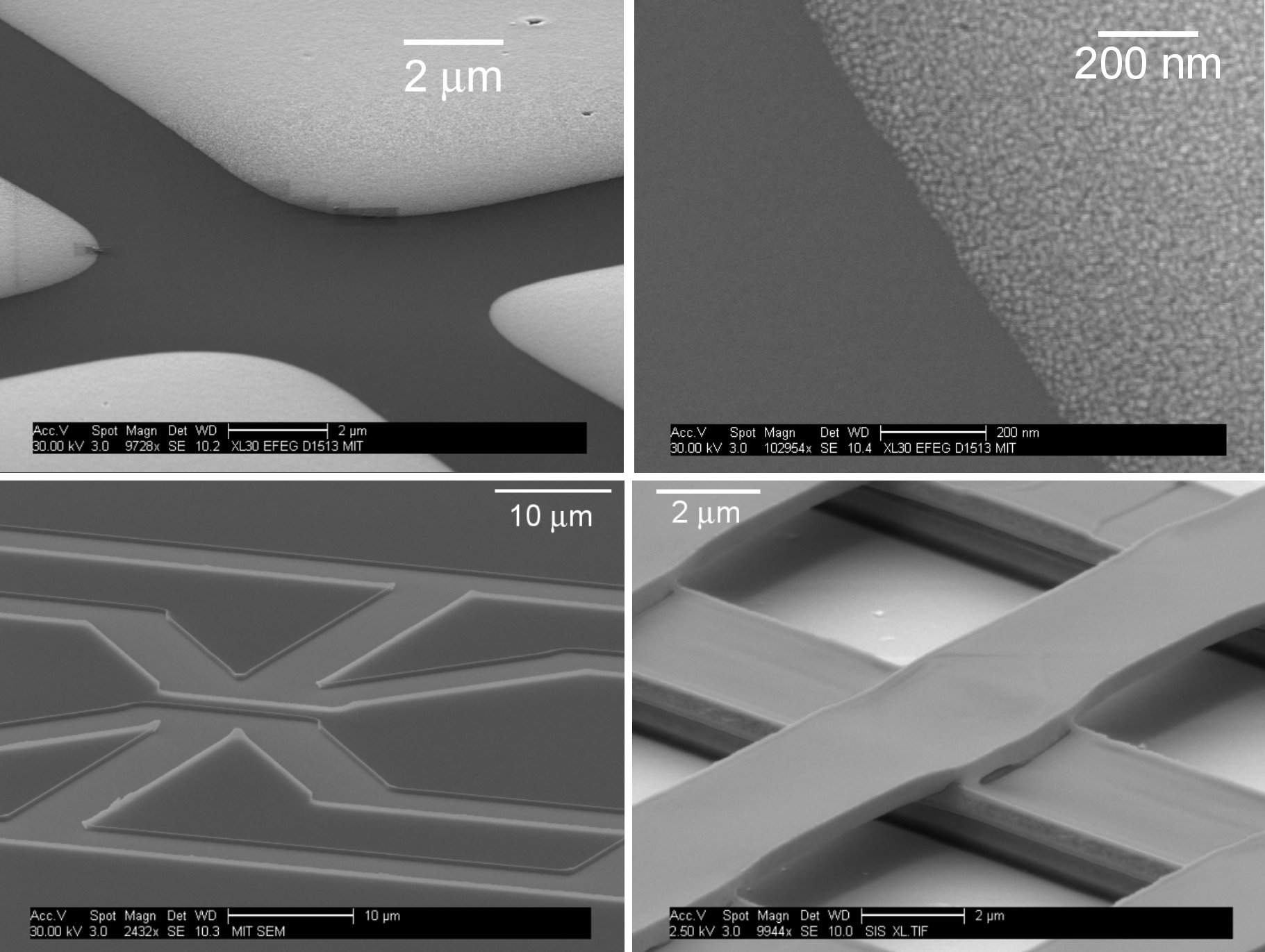
The
offset liquid embossing process was
used to print micro-electromechanical systems,
here producing electrostatic actuators for light modulation (imaging
the displacement with CBA's confocal microscope) [Wilhelm et
al., 2004]:

For finer features, CBA's Focused Ion Beam writer (FIB) was used to directly pattern organometallic nanoparticles to produce nanometer-scale wiring:
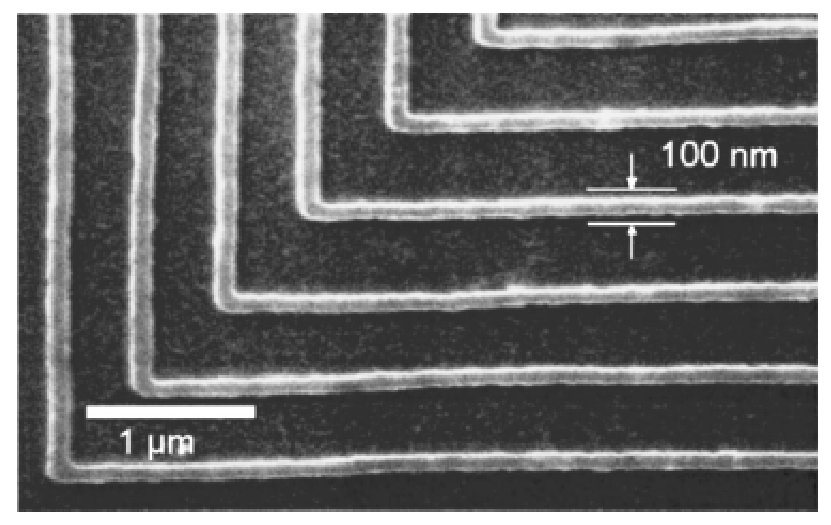
showing the highest
demonstrated throughput for a direct-write process
utilizing organometallic precursors [Kong et al., 2004], and CBA's e-beam
writer was used with the FIB to fabricate
field effect transistors from semiconducting nanowires [Joo et al.,
2007]:
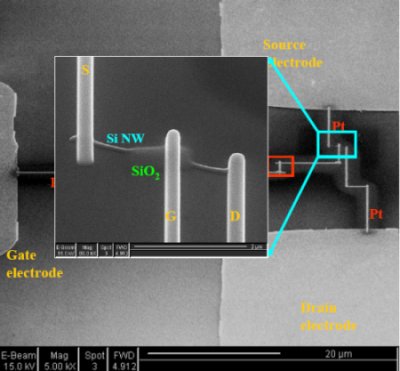
CBA's FIB was also used to notch a SOI substrate that was then fractured at that interface to create a controllable atomically-flat gap:

that can be used as a
molecular-scale valve [Sprunt and Slocum, 2005];
variable microscale gaps were also used for calibration-free complex impedance
spectroscopy of liquids and gases [Ma and Slocum, 2006; Ma et al., 2007].
Molecular detection was shown by a field-effect sensor for electronic readout of DNA hybridization. The
charge per base at the sugar-phosphate backbone extends the size of an
underlying depletion region in the device, shown here differentially
detecting an oligonucleotide
[Fritz et al., 2002]:

A
suspended microchannel resonant mass sensor
provided microfluidic integration and significantly reduced ambient
damping for such functionalized silicon surfaces [Burg and Manalis,
2003], and an integrated tunneling tip and interferometric sensor
provided coherent noise cancellation [Sparks and Manalis, 2004].
Measurement of amplicon intrinsic charge was integrated with resistive
heaters, temperature sensors, and microfluidic valves for label-free nucleic acid amplification
and detection [Hou et al.,
2007]:

For molecular structural
studies, CBA's excimer laser micromachining
system was used to fabricate a slot antenna in a microstripline that
creates an impedance-matched discontinuity that locally converts RF
energy
to a strong homogeneous magnetic field. This has demonstrated the best reported sensitivity for an integrated
spin-resonance probe, here showing the two-dimensional spectra
obtained from a picomolar sample of an acetyl-amide peptide [Maguire et
al., 2007]:
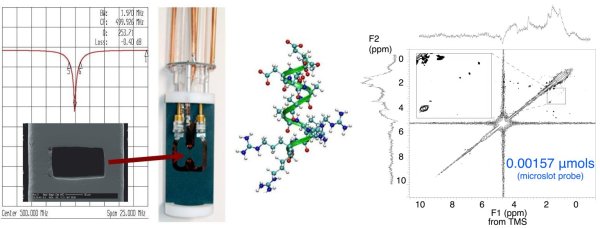
Molecular devices were developed based on the functionality that is available in membrane proteins. Peptide surfactants were synthesized to solubilize, stabilize and crystallize membrane proteins so that they can be used outside of a cell [Yang, 2004]:
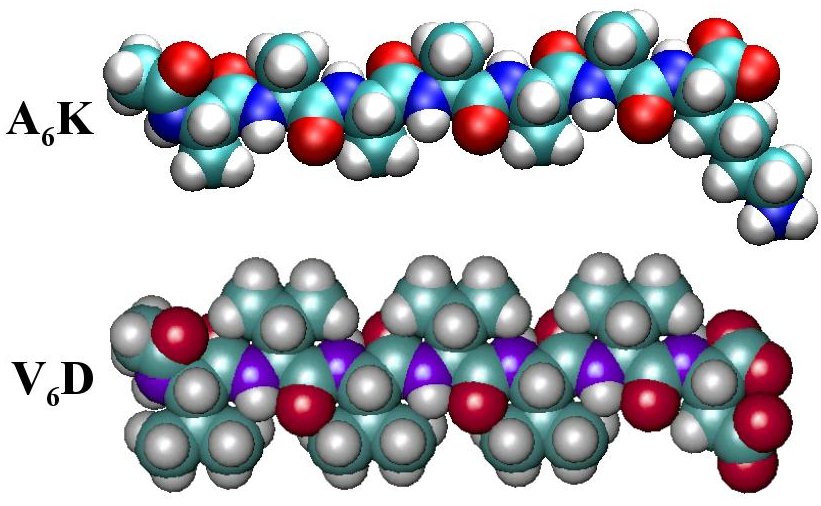
These
were used to retain the functionality of the
photosystem 1 (PS1) complex (from spinach) on a transparent conducting
surface [Kiley et al., 2005]:
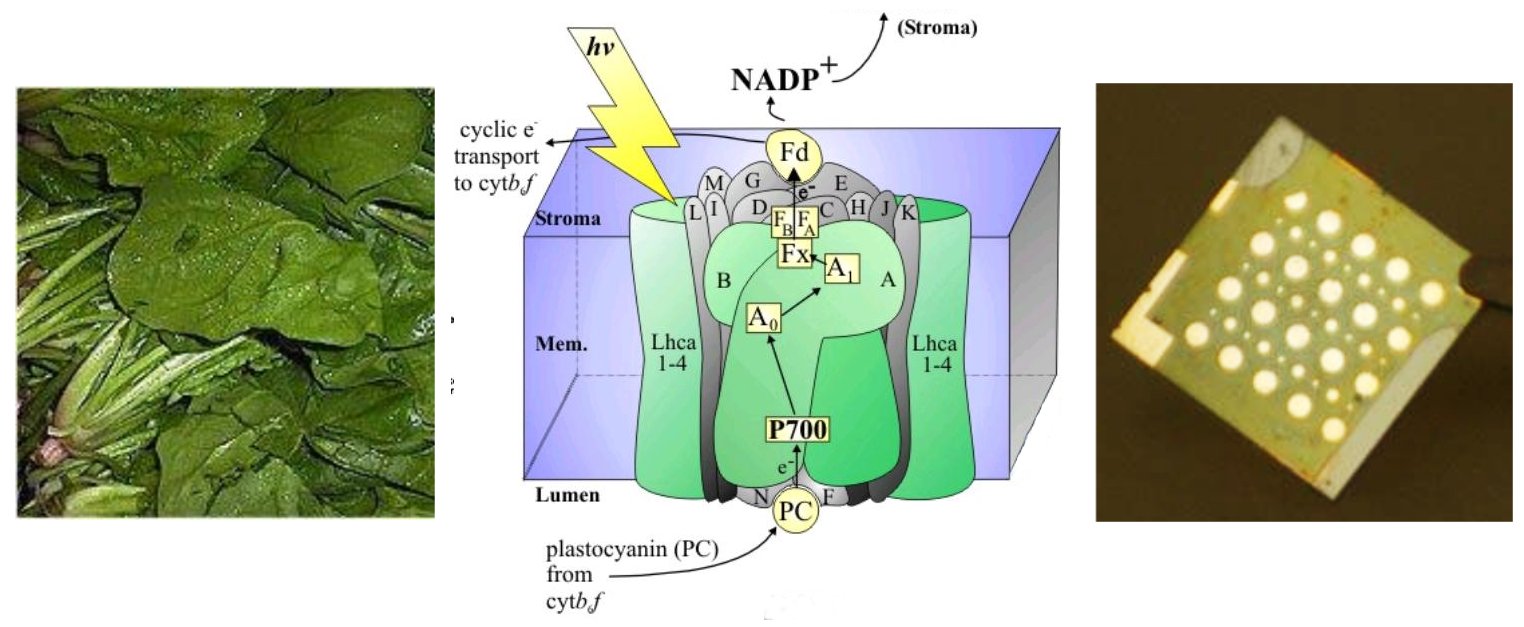
Carbon nanotubes were then used
for electron capture from the PS1, to create a photosynthetic
photovoltaic device [Das et al.,
2004].
For molecular computation, CBA support contributed to the development
of techniques based on nuclear magnetic spin resonance [Gershenfeld and
Chuang, 1997; Vandersypen and Chuang, 2004] that led to some of the
earliest and largest quantum computations to date. Following the
initial implementation of quantum searching
[Chuang, Gershenfeld, and Kubinec, 1998], these include adiabatic optimization [Steffen et al., 2003], and factoring [Vandersypen
et al., 2001], here
showing the 7-qubit molecule (a perfluorobutadienyl
iron complex), circuit, pulse sequence, and spectra for Shor's
algorithm:

Pulse sequences developed for computing with nuclear spins were subsequently applied to ion trap quantum computers, [Guide et al., 2003], and investigation of their scaling resulted in the experimental realization of a planar ion trap array [Pearson et al., 2006], showing loading from a conventional linear Paul trap, linear ion movement, splitting and joining of ion chains, and movement of ions through intersections:

Beyond computation, CBA
researchers are applying concepts from quantum
information to problems ranging from the study of materials
[Lloyd, 2008] to quantum gravity [Lloyd, 2006] and the computational
capacity of the universe [Lloyd, 2002]. Results include an interferometric measurement of the
phase coherence of dark states in Electromagnetically Induced
Transparency (EIT) [Murali et
al., 2004], beating the
standard quantum limit in a positioning system such as GPS by
viewing it as a distributed computation [Giovannetti, Lloyd, and
Maccone, 2004], and analyzing the escape of
quantum information in the Hawking radiation from a black hole
[Lloyd, 2004].
CBA's investigation of the transformation of information in physical
interactions has led to advances in coherent classical as well as
quantum mechanisms. A new approach to information security came from introducing a physical one-way cryptographic function
by showing that photon scattering from inhomogeneous materials in the
mesoscopic limit is equivalent to a one-way hash of the scattering
structure [Pappu et al., 2002]:

And CBA's fabrication facilities were used in the first measurement of the two-dimensional electromagnetic scattering profile of the focusing inside and outside of a negative-index material [Houck et al., 2003; Brock, 2004]:

The study of the integration of
computation into materials led to the invention
of "bubble logic", using two-phase
flows in microfluidic channels to simultaneously transport materials
and perform logic on them, here showing bubble generation, logic,
bistability, and a ring oscillator
[Prakash and Gershenfeld, 2007]:

Capillary
ratchets that can clock microfluidic circuits were discovered
from studying the foraging mechanisms of shorebirds [Prakash et al.,
2008].
CBA's studies of these microscopic means for manipulating information
promise to lead to the creation of macroscopic systems of unprecedented
complexity. Along with investigating the foundations of computation and
fabrication, a number of CBA projects are exploring design principles
and engineering practice appropriate for this limit of enormous
complexity. An emerging programming model is based on "mathematical
programming," compiling problems posed as a mathematical program (goals
with constraints) into distributed dynamics by message-passing
algorithms on the graphical structure associated with sparsity in the
primal and dual problem statements. This approach was applied to
spread-spectrum carrier acquisition and tracking:

to create a Noise-Locked Loop (NLL) as a generalization of Phase-Locked Loops (PLLs) to coded waveforms [Vigoda, 2003; Vigoda et al., 2006]. An NLL circuit was implemented, here compared to simple bit-discrimination on a noisy signal:

This
"analog logic" circuit operates in the state-space of the
corresponding digital system but uses a continuous log-likelihood
voltage representation that takes advantage of the available device
degrees of freedom.
A related project has taken early ideas about fault-tolerant computers
that have since been developed for quantum computing and applied them
back to classical logic, showing that fault-tolerant
designs can improve the reliability and resource efficiency of
classical circuits [Impens,
2004]:

Other work on electronics that
operates between analog and digital
limits has included the development of an ultra-low-leakage
analog storage cell [O'Halloran and Sarpeshkar, 2004], spike-based signal processing [O'Halloran and
Sarpeshkar, 2002], and a time-based analog-to-digital converter
inspired by the operation of spiking neurons:
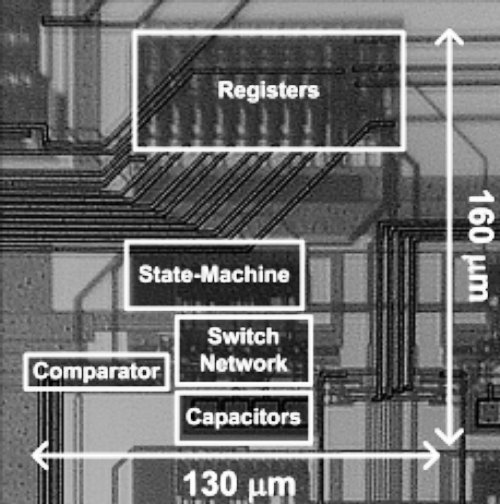
offering the first
conversion time
that scales linearly rather than exponentially with bit precision,
and
the highest reported A/D energy
efficiency [Yang and
Sarpeshkar, 2006].
Computation in distributed systems was investigated in the context of
"paintable" computing, seeking to turn computation into an extensible
raw material by fabricating enormous numbers of simple devices that can
solve global problems through their local interactions. To guide
scaling to silicon, a programming model for a paintable computer was
implemented in a pushpin system, taking as a test problem distributed graphical rendering in a statistical
display medium:
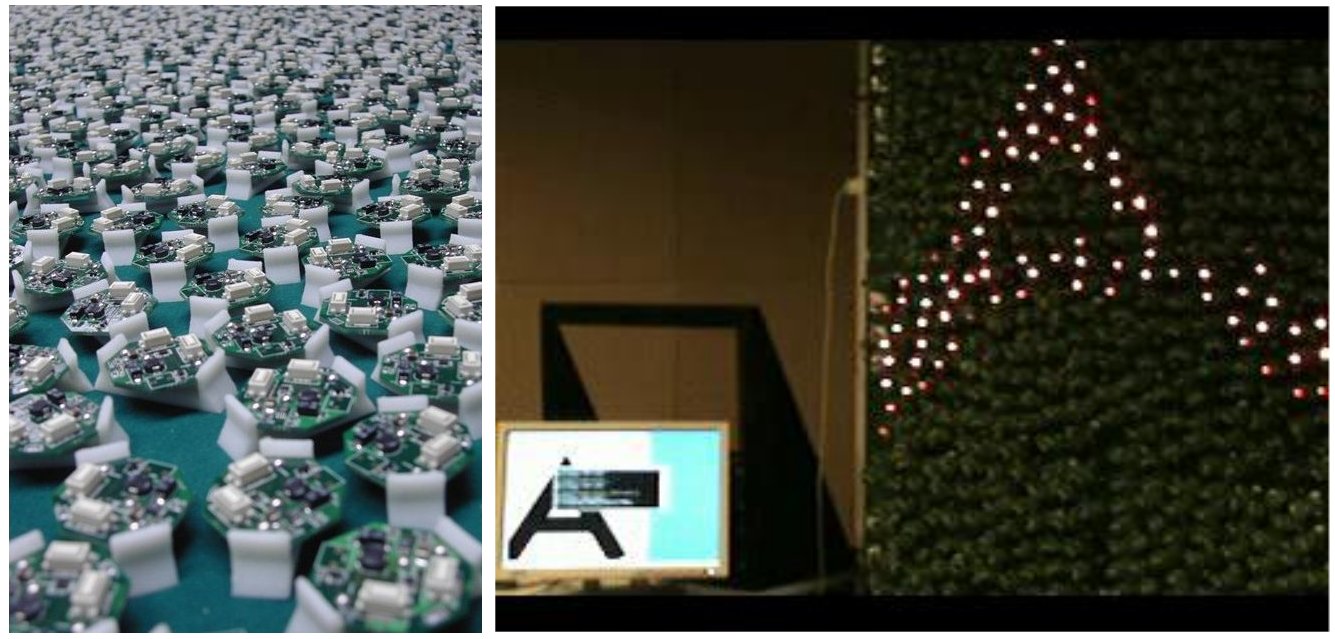
[Butera, 2002], and a similar
system was used to study distributed
localization [Broxton et al.,
2005]. The physical constraints on distributed computation were
reflected in the development of conformal
computing substrates [Gershenfeld, 2008] based on
asynchronous logic automata [Dalrymple, 2008] assembled
by coded folding [Cheung et
al., 2008]:
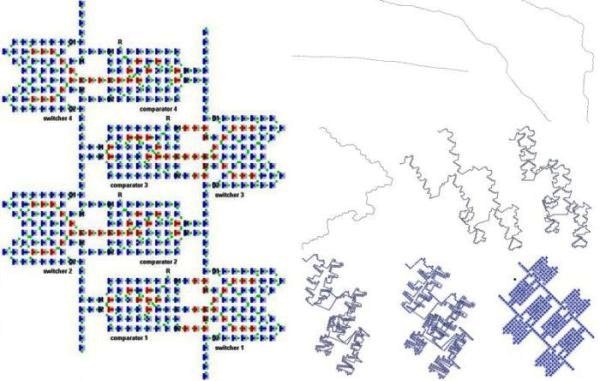
Current work is extending this
architecutre to develop analog logic automata chips for reconfigurable
mixed-signal and statistical processing.
Investigation in CBA of the connection between computational and
physical dynamics resulted in the development of a
dynamically stable bipedal robot that learns to walk in 20 minutes
[Tedrake, 2004; Collins et al.,
2005]:

Current work is extending the online learning algorithms to more complex mechanical systems and terrains [Byl and Tedrake, 2008]. The relationship between mathematical and physical mechanisms for learning is also being investigated at the cellular level, including the development of a printing process to pattern networks of neurons and glia cells [Sanjana and Fuller, 2003]:

CBA facilities were used to
develop the first-ever method for
silencing neural
activity with light [Han
and Boyden, 2007]:

and to make arrays for optically switching on and off 3D brain circuits [Bernstein et al., 2008]. These studies of learning in biological systems are closely connected to CBA's investigation of mathematical programming in engineered systems, which is seeking to forward- rather than reverse-engineer the biological principles underlying the use of local interactions to solve global problems [Lafuente and Gershenfeld, 2008].
Describe
the opportunities for training and development provided by your project.
CBA has directly supported about 100 grad and undergrad students and
indirectly contributed
to training about 200 students (with two subsequently joining
MIT's faculty), working with a unique experimental
resource developed to provide input and output across 9 orders of
magnitude:

A
popular rapid-prototyping class was developed to provide instruction
in its integrated use, MAS.863: How To Make (almost) Anything. Other
classes that have been developed with direct and indirect CBA
contributions include:
hands-on
training in quantum computing in 8.13: Experimental Physics

rapid-prototyping
of microstructures in 6.151: Semiconductor Devices Project Laboratory
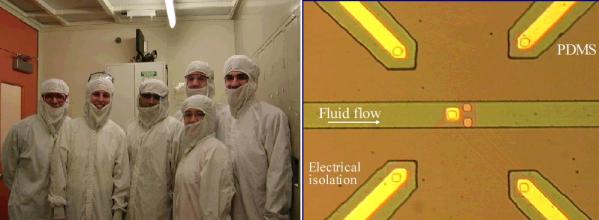
4.206: Introduction to Computing
4.212: Design Fabrication
4.173: Design Fabrication Workshop
6.971: Engineering Simple Biological Systems
7.86, BE.481, MAS.866: Fundamental Limits of Biological Measurement
8.371J, MAS.865J: Quantum Information Science
BE.309: Biological Engineering II: Instrumentation and Measurement
BE.442: Molecular Structure of Biological Materials
MAS.862: The Physics of Information Technology
MAS.864: The Nature of Mathematical Modeling
MAS.961:
How To Make Something That Makes (almost) Anything
CBA's
educational activities have expanded beyond campus, through activities
in the field fab lab network including a 10 module "FabKidz" curriculum
aimed at 6th-8th grade school children that was developed and
administered by a 15-year-old
fab lab participant (who's been working in a fab lab since she was 12)
[Millner and Daily, 2008]:

and
a NSF grant (0802388) to the Midwest Fab Lab Network to integrate
and analyze the impact of digital fabrication in community college
curriculum.
Describe
outreach activities
your project has undertaken.
The focus of CBA's outreach activities has been a growing network of
field "fab labs":

[Gershenfeld, 2005]. Rather
than just communicating research results, fab labs provide access to prototype
tools for personal fabrication in underserved communities around the
world, allowing ordinary people to create as well as consume
technology. Fab lab activities range from technological empowerment to
informal project-based peer-to-peer technical training, to local
problem-solving, to small-scale high-tech business creation, to
grass-roots research and development; projects include high-gain
antennas for mesh wireless networks, low-cost locally-produced
thin-client computers, instrumentation for environmental, agricultural,
and medical measurements, wind, water, and steam turbines, and
rapid-prototyping of housing:

Fab labs have spread in the US
from inner-city Boston to the Midwest to San Diego and the South Bronx,
in Europe from the north of Norway to Barcelona and the
Netherlands, in Africa from Ghana to South Africa to Kenya, to India,
and (with supplemental NSF support) Afghanistan. CBA supports these
labs with communications infrastructure (including hosting a broadband
videoconference), by managing shared inventory and capabilities, and
developing projects and processes (with an ultimate aim of a fab lab
being able to make a fab lab).
Fab lab sites include formal
and informal institutions, community centers and community colleges,
farms and studios. Financial support, initially from CBA, has expanded
to include other philanthropic sources (such as a MacArthur Foundation
award to
the South Bronx fab lab) and government sources (such as South Africa's
national fab lab
network). This response has been matched by public
and press interest, with features in media including The Economist, USA Today, NPR, BBC, and CNN.
To keep up with the growth of fab labs, an independent non-profit Fab
Foundation is being launched to support invention as aid, a for-profit
Fab Fund to help global capital reach local inventors and local
inventions find global markets, and a Fab Academy to provide
distributed advanced technical education in principles and applications
of digital fabrication. The emergence of these organizations can be
understood as an ultimate
impact of the work of CBA and its partners. Bringing together computer
science and physical science has led to the development of digital
fabrication, in turn enabling personal fabrication. And the
availability of prototype tools for personal fabrication is allowing
anyone anywhere to be able to make almost anything. Combined with video
networks and online libraries, this means that previously scarce
resources of advanced research and educational institutions can become
much more widely distributed and broadly accessible.
Since 2004 CBA has co-organized an annual global gathering of the field fab lab and
digital fabrication research communities, co-hosted in 2007 with NSF and the
Department of
Energy: http://cba.mit.edu/events/07.08.fab/.
A mobile
fab lab was developed
for this event, here shown at Chicago's Museum of Science and Industry:

Such topical meetings targeting emerging research areas have been an important component of CBA's outreach within the scientific community. These have included meetings on Coding and Computation in Microfluidics [http://cba.mit.edu/events/07.05.fluid/], Energy and Computation: Flops/Watt and Watts/Flop [http://cba.mit.edu/events/06.05.energy/], Digital Fabrication [http://cba.mit.edu/events/06.06.ZA/symposium.html], Avogadro-Scale Engineering [http://cba.mit.edu/events/03.11.ASE/], Quantum Information Processing [http://cba.mit.edu/events/05.01.QIP/]
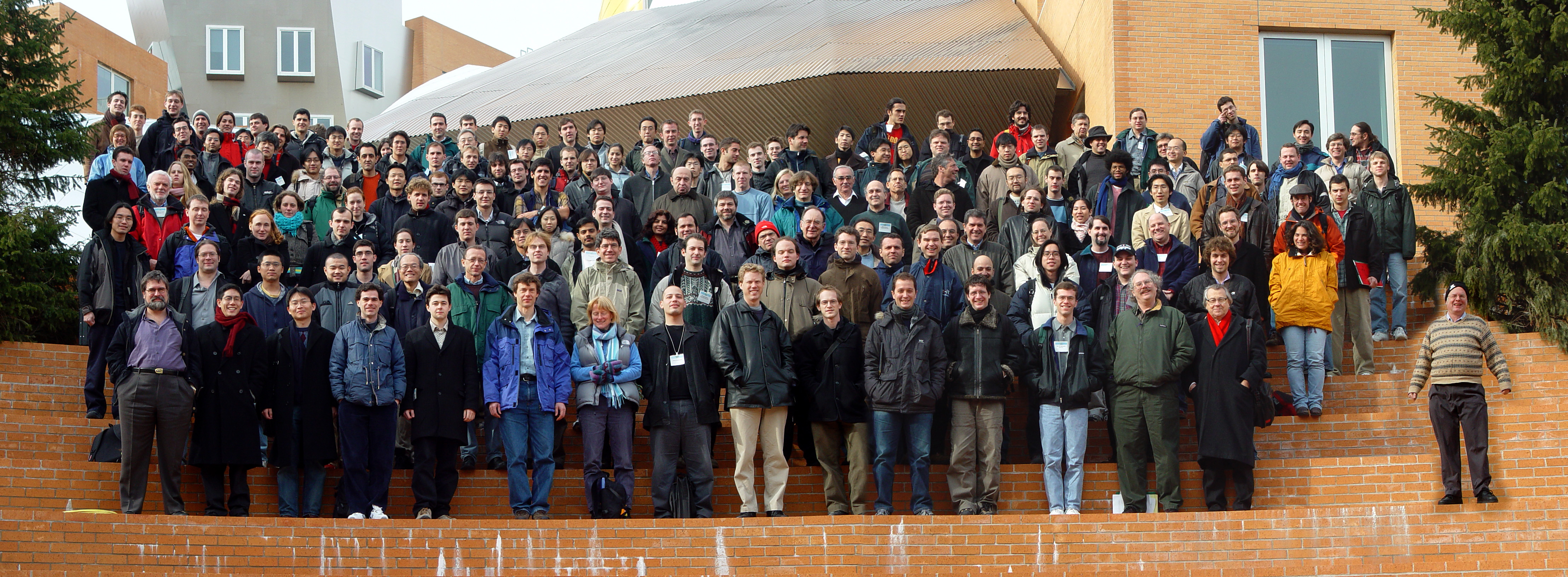
and Internet 0 [http://cba.mit.edu/events/04.09.I0/]. The latter gathered original Internet architects as well as current counterparts, and industrial partners. At the meeting a parallel was seen between the early days of the Internet and embedded networking today, with Internet 0's time-domain impulse-response encoding:
![]()
providing end-to-end modulation to enable interdevice internetworking:
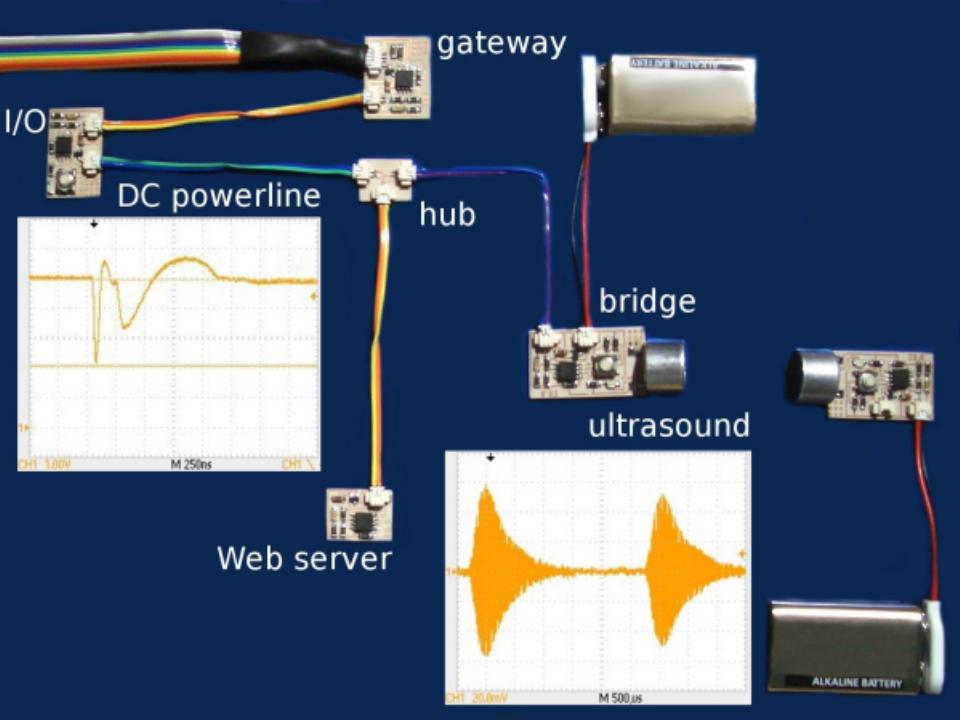
[Gershenfeld et al., 2004;
Gershenfeld and Cohen, 2006]. A follow-up event on energy applications [http://cba.mit.edu/events/07.05.energy/]
led to launching a project on Intelligent
Infrastructure for Energy Efficiency
(I2E), in cooperation with Department of Energy national labs and
industrial partners, for large-scale testbeds applying Internet 0 to
building energy efficiency:
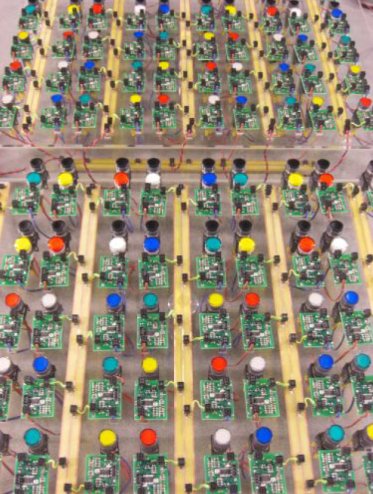
Another form of outreach has been through projects using CBA's rapid-prototyping facilities. One is a concept car project with Prof. Bill Mitchell, Frank Gehry, and General Motors that is developing an electric one-way share vehicle:

Another is with Drs. Florence Friedman (Brown University) and Walter Gilbert (Harvard University), working with CBA's shop technician John Difrancesco to 3D scan, virtually assemble, and print fragments of antiquities from the collection of Boston's Museum of Fine Arts:

What have you published as a
result of this work?
Journal publications
M. Aubin-Tam and K. Hamad-Schifferli, "Cytochrome c Complexes: The
Effect of Nanoparticle Ligand Charge on Protein Structure," Langmuir (21), pp. 12080-12084 (2005)
M.-E. Audin, D.G. Morales, K. Hamad-Schifferli, "Labeling Ribonuclease
S with a 3nm Au nanoparticle by two-step assembly," Nano Lett. 5 (3), 519-522 (2005)
D. Baker, G. Church, J. Collins, D. Endy,
J. Jacobson, J. Keasling, P. Modrich, C. Smolke,
and R. Weiss, "Engineering Life: Building a FAB for Biology," Scientific American (294), pp. 44-51 (2006)
J. Bernstein, X. Han, M. Henninger, E. Ko, X. Qian, G. Talei Franzesi,
J. McConnell, P. Stern, R. Desimone, E.S. Boyden, "Prosthetic
Systems for Therapeutic Optical Activation and Silencing of
Genetically-Targeted Neurons," Proceedings of the SPIE Vol. 6854,
68540H:1-11, Optical Interactions with Tissue and Cells XIX, Steven L.
Jacques; William P. Roach; Robert J. Thomas, Editors (2008)
Jeffrey B. Brock, Andrew A. Houck, and Isaac L. Chuang, "Focusing
inside negative index materials," Applied Physics Letters (85), pp. 2472-4 (2004)
M. Broxton, J. Lifton, J.A. Paradiso, "Wireless Sensor Node
Localization Using Spectral Graph Drawing and Mesh Relaxation,"
submitted (2005)
C.
Bulthaup, E. Wilhelm, B. Hubert, B. Ridley, and J. Jacobson,
"All-Additive Fabrication of Inorganic Logic Elements by Liquid
Embossing," Applied Physics Letters (79), pp. 1525-1527
(2001)
T. Burg and S.R.
Manalis, "Suspended microchannel resonators for biomolecular
detection," Applied Physics
Letters (83), 2698 (2003)
Katie Byl and Russ Tedrake, "Metastable Walking on Stochastically Rough
Terrain," in Proceedings of
Robotics: Science and Systems IV (2008)
Peter A. Carr, Jason S. Park, Yoon-Jae Lee, Tiffany Yu, Shuguang Zhang,
and Joseph M. Jacobson, "Protein-mediated error correction for de novo
DNA synthesis," Nucleic
Acids Research 32
(20), e162/1-e162/9 (2004)
Kenneth Cheung, Erik Demaine, Neil Gershenfeld, "Folding Programs," to
be published (2008)
K. Cheung and N. Gershenfeld, "Automated Assembly of Large-Scale
Digital Structures," to be published (2008)
T. Choudhury, B. Clarkson, S. Basu, and A. Pentland, "Learning
Communities: Connectivity and Dynamics of Interacting Agents," Proceedings
of the International Joint Conference on Neural Networks, 2003
Brian Y. Chow, David W. Mosley, and Joseph M. Jacobson, "Perfecting
Imperfect Monolayers: Removal of Siloxane Multilayers by CO2 Snow
Treatment," Langmuir 21(11), pp. 4782-4785 (2005)
Isaac L. Chuang, Neil Gershenfeld, and Mark Kubinec, "Experimental
Implementation of Fast Quantum Searching," Phys. Rev. Lett. (80), pp.
3408-3411 (1998)
Steven H. Collins, Andy Ruina, Russ Tedrake, and Martijn Wisse,
"Efficient bipedal robots based on passive-dynamic walkers", Science (307), pp. 1082-1085 (2005)
E.B.
Cooper, J. Fritz, G. Wiegand, P. Wagner, and S.R. Manalis, "Robust
Microfabricated Field-Effect Sensor for Monitoring Molecular Adsorption
in Liquids," Applied Physics Letters (79), pp. 3875-3877 (2001)
J. Fritz, E.B.
Cooper, S. Gaudet, et al.,
"Electronic Detection of DNA by its
Intrinsic Molecular Charge," P.
Nat. Acad. Sci (99), pp.
14142-14146 (2002)
R. Das, P.J. Kiley, M. Segal, J. Norville, A. Yu, L. Wang, S. Trammell,
L.E. Reddick, R. Kumar, F. Stellacci, N. Lebedev, J.M Schnur, B.D.
Bruce, S. Zhang, and M. Baldo, "Integration of phtosynthetic protein
molecular complexes in solid-state electronic device," Nano Letters (4), pp. 1079-1083 (2004)
S.B.
Fuller, E.J. Wilhelm, and J.M. Jacobson, "Ink-jet Printed Nanoparticle
Microelectromechanical Systems," Journal of Microelectromechanical Systems (11), pp. 54-60
(2002)
N. Gershenfeld, R.
Krikorian, and D. Cohen, "The Internet of Things," Scientific American (291), pp. 76-81 (2004)
Neil A. Gershenfeld and Isaac L. Chuang, "Bulk Spin-Resonance Quantum
Computation," Science (275), pp. 350-356 (1997)
N. Gershenfeld and D. Cohen, "Internet 0: Interdevice Internetworking,"
IEEE Circuits and Devices (22), pp. 48-55 (2006)
Neil Gershenfeld, "Programming Bits and Atoms", to be published (2008)
Vittorio Giovannetti, Seth Lloyd, and Lorenzo Maccone,
"Quantum-Enhanced Measurements: Beating the Standard Quantum Limit," Science (19), pp. 1330-1336 (2004)
D.
Gottesman and I. Chuang, "Quantum Digital Signatures,"
http://arxiv.org/abs/quant-ph/0105032 (2001)
S. Griffith, D. Goldwater, and J.M. Jacobson,
"Self-Replication From Random Parts," Nature (437), p. 636
(2005)
Saul Griffith, James
McBride, Benjamin Su, Bobby Ren, and Joseph M. Jacobson, "Folding Any
3D Shape," to be published (2005).
Saul Griffith, Mark Mondol, David S. Kong, and Joseph M. Jacobson, "Nanostructure fabrication by direct
electron-beam writing of nanoparticles," J. Vac. Sci. Technol. (B 20), 2768-2772 (2002)
S. Gulde, M. Riebe, G.P.T. Lancaster, C. Becher, J. Eschner, H.
Häffner, F. Schmidt-Kaler, I.L. Chuang, R. Blatt, "Implementing the
Deutsch-Jozsa algorithm on an ion-trap quantum computer," Nature (421), pp. 48-50 (2003)
K.
Hamad-Schifferli, J.J. Schwartz, A.T. Santos, S.G. Zhang, and J.M.
Jacobson, "Remote Electronic Control of DNA Hybridization Through
Inductive Coupling to an Attached Metal Nanocrystal Antenna," Nature (415), pp. 152-155,
(2002)
X. Han and
E.S. Boyden, "Multiple-Color Optical Activation, Silencing, and
Desynchronization of Neural Activity, with Single-Spike Temporal
Resolution," PLoS ONE 2(3): e299 doi:10.1371/journal.pone.0000299 (2007)
C.J. Hou, N. Milovic, M. Godin, P.R. Russo, R. Chakrabarti, and S.R.
Manalis, "Label-free Microelectronic PCR Quantification," Analytical Chemistry (78), p. 2526 (2006)
C.J. Hou, M. Godin, K. Payer, R. Chakrabarti, S.R. Manalis, "Integrated
Microelectronic Device for Label-free Nucleic Acid Amplification and
Detection," Lab on a Chip
(7), p. 347 (2007)
A.A. Houck, J.B.
Brock, and I.L. Chuang, "Experimental Observations of a Left-Handed
Material That Obeys Snell's Law," Phys. Rev. Lett. (90), 137401/1-4 (2003)
J. Joo, B.Y. Chow, and J.M. Jacobson, "Nanoscale Patterning
on Insulating Substrates by Critical Energy Electron Beam Lithography,"
Nano Letters (6), pp. 2021-2025 (2006)
J. Joo, S. Moon, and J.M. Jacobson, "Ultrafast Patterning of
Nanoparticles by Electrostatic Lithography," J. Vac. Sci. B., to appear (2006)
Jaebum Joo, Kimin Jun, and Joseph M. Jacobson, "Simple fabrication of
UV Nanoimprint Lithography Templates by Critical Energy Electron Beam
Lithography," J. Vac. Sci. Technol. B (25), pp. 2407-2411 (2007)
P. Kiley, X. Zhao, M. Vaughn, M. Baldo, B.D. Bruce, and S. Zhang,
"Designed short peptide detergents stabilize the structure of
photosystem I membrane protein complex," PLoS Biol. 3, in press (2005)
David S. Kong, Jonathan S. Varsanik, Saul Griffith, and Joseph M.
Jacobson, "Conductive nanostructure fabrication by focused ion beam
direct-writing of silver nanoparticles," Journal of Vacuum Science &
Technology, B: Microelectronics and Nanometer Structures--Processing,
Measurement, and Phenomena
22(6), 2987-2991 (2004)
D.S. Kong, V. Anant, A. Salomon, W. Delhagen, H. Nair, J. Varsanik and
J.M. Jacobson, "Nanostructure Fabrication by Direct E-Beam Writing of
Purely Inorganic Nanoparticles," Intl. Conf. on Electron, Ion, and Photon
Beam Technology and Nanofabrication (2003 )
Luis Lafuente Molinero and Neil Gershenfeld, "Conformal
Mathematics," to be published (2008)
J. Lifton, D.
Seetharam, M. Broxton, J. Paradiso, "Pushpin Computing System Overview:
a Platform for Distributed, Embedded, Ubiquitous Sensor Networks," Proc. of the Int.
Conf. on Pervasive Computing, Zurich (2002)
Joshua Lifton, Deva
Seetharam, Michael Broxton, Joseph Paradiso, "Pushpin Computing System
Overview: a Platform for Distributed, Embedded, Ubiquitous Sensor
Networks," in F. Mattern and M. Naghshineh (eds): Pervasive 2002, Proceedings of the
Pervasive Computing Conference, Zurich Switzerland, 26-28 August 2002,
Springer Verlag, Berlin Heidelberg, pp. 139-151
S. Lloyd, "Computational Capacity of the Universe," Phys. Rev. Lett.
(88), 237901 (2002)
S. Lloyd, "Power of
Entanglement in Quantum Communication," Phys. Rev. Lett. (90), 167902 (2003)
S. Lloyd, "Almost
certain escape from black holes," quant-ph/0406205
(2004)
S. Lloyd. "A Theory of Quantum Gravity Based on Quantum Computation,"
arXiv:quant-ph/0501135v8 (2006)
S. Lloyd, "Quantum Information Matters," Science (319), pp. 1209- 1211
(2008)
A. Lomander, W. Hwang,
and S. Zhang, "Hierarchical Self-Assembly of a Coiled-Coil Peptide Into
Fractal Structure," Nano
Letters (5), pp. 1255-1260
(2005)
H. Ma, J. White, J.
Paradiso, and A. Slocum, "Sub-nanometer Displacement Sensing for the
Nanogate," In the Proceedings of the 2003 IEEE
International Conference on Sensors, October 21-24, Toronto Canada, pp. 46-51
(2003)
Hongshen Ma, J.H. Lang, and A.H. Slocum, "Design of an Electrochemical
Impedance Test Cell with Servomechanically Adjustable Cell Constant,"
IEEE Sensors, pp. 1233-1236 (2007)
M.J.
MacLachlan, A. Rose, and T.M. Swager, "A Rotaxane Exciplex,” J. Am. Chem. Soc. (123), pp. 9180-9181 (2001)
Y. Maguire, I.L. Chuang, S. Zhang, and N. Gershenfeld,
"Ultra-Small-Sample Molecular Structure Detection Using Microslot
Waveguide Nuclear Spin Resonance," Proceedings of the National Academy of
Sciences (104), pp.
9198-9203 (2007)
B. Mikhak, C. Lyon, T. Gorton, N. Gershenfeld, C. McEnnis, J. Taylor,
"FAB LAB: An Alternate Model of ICT for Development," 2nd International Conference on Open
Collaborative Design for Sustainable Innovation, Bangalore, India, 2002
N. Milovic, J. Behr, M. Godin, C.J. Hou, K.R. Payer, A. Chandrasekaran,
P.R. Russo, R. Sasisekharan, and S.R. Manalis, "Monitoring of Heparin
and Its Low Molecular Weight Analogs by Silicon Field Effect," Proceedings of the National Academy of
Sciences (2006).
W.J. Mitchell, "Constructing Complexity in the Digital Age," Science (303), pp. 1472-1473 (2004)
D. Mosley, B.Y. Chow, and J.M. Jacobson, "Solid-State Bonding Technique
for Template-Stripped Ultraflat Gold Substrates," Langmuir (22), pp. 2437-2440 (2006)
K.V.R.M. Murali, Hyung-Bin Song, Matthias Steffen, Patrick Judeinstein,
and Isaac L. Chuang, "Test by NMR of the Phase Coherence of
Electromagnetically Induced Transparency," Phys. Rev. Lett. (93), 033601 (2004)
M. O'Halloran and R. Sarpeshkar, "A 10-nW 12-bit Accurate Analog
Storage Cell with 10-aA Leakage," IEEE Journal of Solid State Circuits (39), pp. 1985-1996 (2004)
M. O'Halloran and R. Sarpeshkar, "Scalable Hybrid Computation with
Spikes," Neural Computation
(14), pp. 2003-2038
(2002)
M.
O’Halloran and R. Sarpeshkar, "A Low Open-Loop Gain, High-PSRR,
Micropower CMOS Amplifier for Mixed-Signal Applications," Proc. of the IEEE
Conf. On Circuits and Systems, (Vol. II), pp. 424-427 (2002)
M. Oskin, F.T. Chong, I.L. Chuang IL, "A Practical Architecture for
Reliable Quantum Computers", Computer (35), pp. 79-87 (2002)
R. Pappu, B. Recht, J.
Taylor, N. Gershenfeld, "Physical One-Way Functions," Science (297) pp. 2026-2030 (2002)
S. Park, K.A. Brown, K. Hamad- Schifferli, "Changes in oligonucleotide
conformation on nanoparticle surfaces by modification with
mercaptohexanol," Nano Lett. 4 (10), 1925-1929 (2004)
C.E. Pearson, D.R. Leibrandt, W.S. Bakr, W.J. Mallard, K.R. Brown, and
I.L. Chuang, "Experimental Investigation of Planar Ion Traps," Phys. Rev. A (73), 032307 (2006)
M. Prakash and N. Gershenfeld, "Microfludic Bubble Logic," Science (315), pp. 832-835 (2007)
Manu Prakash, David Quere and John W. M. Bush, "Surface Tension
Transport of Prey by Feeding Shorebirds: The Capillary Ratchet," Science (320), pp. 931-934 (2008)
M.
Resnick, "Rethinking Learning in the Digital Age," in The Global
Information Technology Report: Readiness for the Networked World, edited by G.
Kirkman, Oxford University Press (2002)
N. E. Sanjana and S. B. Fuller, "A fast flexible ink-jet printing
method for patterning dissociated neurons in culture," Journal of Neuroscience Methods (136), pp. 151-163 (2004)
S. Santoso, W. Hwang, H. Hartman, S. Zhang, "Self-Assembly of
Surfactant-Like Peptides with Variable Glycine Tails to Form Nanotubes
and Nanovesicles," NanoLetters (2), pp. 687-691 (2002)
A.W. Sparks and S.R. Manalis, "Scanning probe microscopy with inherent
disturbance suppression", Applied
Physics Letters, (85), pp.
3929-3931 (2004)
F. Standaert, G. Piret, N. Gershenfeld, and J. Quisquater, "SEA: a
Scalable Encryption Algorithm for Small Embedded Applications,"
Springer Lecture Notes in Computer Science (3928), pp. 222-236 (2006)
M. Steffen, J. Martinis, I. Chuang, "Accurate control of Josephson
phase qubits," Physical
Review B (68), pp
224518/1-9, 2003
M. Steffen, W. van Dam, T. Hogg, G. Breyta, and I. Chuang,
"Experimental Implementation of an Adiabatic Quantum Optimization
Algorithm," Phys. Rev. Lett. (90), 067903 (2003)
Kie-Moon Sung, David W. Mosley, Beau R. Peelle, Shuguang Zhang, and
Joseph M. Jacobson, "Synthesis of Monofunctionalized Gold Nanoparticles
by Fmoc Solid-Phase Reactions," J.
Am. Chem. Soc (126),
5064-5065 (2004)
R.
Tedrake and H. Sebastian Seung, "Improved Dynamic Stability using
Reinforcement Learning," 5th International Conference on Climbing
and Walking Robots (CLAWAR), Professional
Engineering Publishing Limited (2002)
Russ Tedrake, Teresa
Weirui Zhang, Ming-fai Fong, and H. Sebastian Seung, "Actuating a
Simple 3D Passive Dynamic Walker," IEEE International Conference on
Robotics and Automation
(ICRA 2004)
L.M.K. Vandersypen and I.L. Chuang, "NMR Techniques for Quantum Control
and Computation," Rev. Mod.
Phys. (76), pp. 1037-1069
(2004)
M.K.
Vandersypen, M. Steffen, G. Breyta, C.S. Yannoni, M.H. Sherwood, and
I.L. Chuang, "Experimental Realization of Shor's Quantum Factoring
Algorithm using Nuclear Magnetic Resonance," Nature (414), pp. 883-887
(2001)
Eric J. Wilhelm, Brian T. Neltner, and Joseph M. Jacobson,
"Nanoparticle-based microelectromechanical systems fabricated on
plastic," Applied Physics
Letters (85), pp.
6424-6426 (2004)
Eric J. Wilhelm and Joseph M. Jacobson, "Direct printing of
nanoparticles and spin-on-glasses by offset liquid embossing," Appl. Phys. Lett. (84), 3507 (2004)
D.W. Mosley, M.A.
Sellmyer, J. Jacobson, "Formation, Patterning, and Polymerization of
Surface Adlayers Using Self-Assembled Monolayers as Templates," Proceedings
of the Materials Research Society, 2003
David W. Mosley, Mark
A. Sellmyer, Erin J. Daida, and Joseph M. Jacobson., "Polymerization of
Diacetylenes by Hydrogen Bond Templated Adlayer Formation," J. Amer. Chem. Soc. (125), pp. 10532-33 (2003)
B. Vigoda, H. Dauwels, M. Frey, N. Gershenfeld, T. Koch, H.-A.
Loeliger, and P. Merkli, "Synchronization of Pseudo-Random Signals by
Forward-Only Message Passing with Application to Electronics Circuits,"
IEEE Transactions of
Information Theory (52),
pp. 3843-3852 (2006)
H. Yang, and R. Sarpeshkar, "A Bio-inspired Ultra-Energy-Efficient
Analog-to-Digital Converter for Biomedical Applications," IEEE Transactions on Circuits and Systems I
(53), pp. 2349-2356 (2006)
H. Yokoi, T. Kinoshita, and S. Zhang, "Dynamic Reassembly of Peptide
RADA16 Nanofiber Scaffold," Proc.
Natl. Acad. Sci. (102), pp.
8414-8419 (2005)
Zhang,
S., "Fabrication of novel materials through molecular self-assembly," Nature
Biotechnology (21), 1171-1178 (2003)
O. Zuckerman and M.
Resnick, "System Blocks: A Physical Interface for System Dynamics
Learning," International
System Dynamics Conference,
New York City, 2003
Books or other
non-periodical, one-time publications
Sumit Basu, Conversational
Scene Analysis, Ph.D.
thesis, MIT (2002)
Robert Beverly, Statistical Learning
in Network Architecture, Ph.D. thesis, MIT (2008)
Rahul Bhargava, Designing a
Computational Construction Kit for the Blind and Visusally Impaired , M.S. thesis, MIT (2002)
Jeff Brock, Refraction and
Focusing in Negative Index Materials, S.B. thesis (2003)
W.
Butera, Programming a Paintable Computer, Ph.D. thesis, MIT
(2002)
K. Byl and R. Tedrake, Stability
of Passive Dynamic Walking on Uneven Terrain in Proceedings of Dynamic Walking 2006, A. Kuo, editor (2006)
Brian P. Clarkson, Life
Patterns: structures from wearable sensors, Ph.D. thesis, MIT (2002)
David Dalrymple, Asynchronous Logic
Automata, M.S. thesis, MIT (2008)
S.B.
Fuller, A Fast Flexible Ink-Jet Printing Method
for Patterning Networks of Neurons in Culture, M.S. thesis, MIT
(2003)
Neil Gershenfeld, The
Coming Revolution on Your Desktop: From Personal Computers to Personal
Fabrication, Basic Books
(2005)
Timothy Gorton, Tangible
Toolkits for Reflective Systems Modeling, M.S. thesis, MIT (2003)
Saul
Griffith, Growing Machines, Ph.D. thesis, MIT
(2004)
K. Hamad-Schifferli,
in Encyclopedia of
Nanoscience and Nanotechnology, edited by J. A. Schwarz, C. Contescu and
K. Putyera (Marcel Dekker, New York, 2003)
K.
Hamad-Schifferli, DNA Hybridization, Electronic Control, in Encyclopedia of
Nanoscience and Nanotechnology, edited by J. A. Schwarz, C. Contescu
and K. Putyera (Marcel Dekker, New York, 2004).
Matthew Hancher, A Motor Control Framework for Many-Axis
Interactive Robots, M.S.
thesis, MIT (2003)
F.
Impens, Fine-Grained Fault-Tolerance:
Reliability as a Fungible Resource, M.S. thesis, MIT
(2004)
Daniel Kornhauser, Designing a Craft Computing Environment
for Non-Industrial Settings,
M.S. thesis, MIT (2002)
Murali Kota, An Approach to
Bridging Atom Optics and Bulk Spin Quatum Computation, Ph.D. thesis, MIT (2003)
Che King Leo, Contact and
Free-Gesture Tracking for Large Interactive Surfaces , M.S. thesis , MIT (2002)
S. Daniel Lovell, A System
for Real-Time Gesture Recognition and
Classification of
Coordinated Motion, M.S.
Thesis, MIT (2005)
S.
Levy-Tzedek, Biological Detection by Means of Mass
Reduction in a Suspended Microchannel Resonator, M.S. thesis, MIT
(2004)
Ji Li, Improving Application-level Network
Services with Regions ,
M.S. thesis, MIT (2003)
Ji Li, Agent Organization in the
Knowledge Plane, Ph.D. thesis, MIT (2008)
J. Lifton, Pushpin Computing: a
Platform for Distributed Sensor Networks,
M.S.
thesis, MIT (2002)
Yanni Loukissas, Rulebuilding: Exploring Design Worlds
through End-Use Programming,
M.S. thesis, MIT (2003)
Christopher Lyon, Encouraging
Innovation by Engineering the Learning Curve , M.S. thesis, MIT (2003)
H. Ma and A. Slocum, A Mechanism for Creating Variable
Nanometer Gaps, in the Proceedings of the
2006 American Society for Precision Engineering Annual Meeting, October 15-20,
Monterey, CA (2006)
Yael Maguire, Scalable Electromagnetic Microstructure
Instrumentation, Ph.D. thesis, MIT (2004)
Micah O’Halloran, A Clock-Based Analog Memory Element for
Integrated Circuits, M.S.
thesis, MIT (2002)
Amon Millner, Hook-ups: How
Youth Learn Through Creating Physical Computer Interfaces, M.S. thesis, MIT (2005)
A. Millner and S. Daily, Creating an
Educational Ecosystem for Design, Personal Fabrication, and Invention,
in Communities of Practice: Creating
Learning Environments for Educators, C. Kimble and
P. Hildreth, eds (Information Age Publishing, Charlotte, NC, 2008)
Sunho Park, Control of Oligonucleotide Conformation
on Nanoparticle Surfaces for Nanoscale Heat Transfer Study, M.S. thesis, MIT
(2004)
C.E. Pearson,Theory and Application of Planar Ion
Traps, M.S. Thesis, MIT (2006)
G.A. Popescu, P. Kunzler,
and N. Gershenfeld, Digital
Printing of Digital Materials, DF
2006 International Conference on
Digital Fabrication Technologies, Denver, Colorado (2006)
G.A. Popescu, N. Gershenfeld, and T. Mahale, Digital Materials for Digital Printing, DF 2006 International Conference on
Digital Fabrication Technologies, Denver, Colorado (2006)
Ben Recht, Convex Modeling
with Priors, Ph.D. Thesis,
MIT (2006)
M. Resnick, Computer as
Paintbrush: Technology, Play, and the Creative Society, in Play = Learning: How play motivates and
enhances children's cognitive and social-emotional growth, D. Singer, R. Golikoff,
K. Hirsh-Pasek (eds.), Oxford University Press (2006)
Lawrence Sass, Wood
Frame Grammar: CAD scripting a wood frame house, CAAD
Futures Conference, Vienna
(2005)
L. Sass and M. Botha, The
Instant House: A Digital Fabrication System for Design Model and Full
Scale Wood Frame Housing,
IS&T Digital Fabrication Conference, Denver, Colorado (2006)
Maxim
Shusteff, A Microfabricated Hollow Cantilever
Sensor for Sub-nanoliter Thermal Measurements, M.S. thesis, MIT
(2003).
A. Slocum, S. Awtar,
A. Elmouelhi, M. Graham, P. Willoughby, "Paths-to-Peace, A New Method
for Teaching Design and Manufacturing", 2nd International Conference on Open
Collaborative Design for Sustainable Innovation, Bangalore, India, 2002
Casey Smith, Material
Design for a Robotic Arts Studio, M.S. thesis, MIT (2002)
Alexander Sprunt and Alexander Slocum, "Fracture fabrication of single
crystal silicon nanosurfaces", EUSPEN
5th International Conference, Vol. 1., pp. 73-76 (2005)
Matthias Steffen, A
Prototype Quantum Computer Using Nuclear Spins in Liquid Solution, Ph.D. thesis, MIT (2003)
W.D. Stiehl, L. Lalla, and C. Breazeal, A Somatic Alphabet
Approach to Sensitive Skin, Proceedings of the ICRA (2004)
Amy Sun, Field Fabrication of Solar-Thermal
Powered Steam Turbines for Generation of Mechanical Power, M.S. Thesis, MIT
2006
Kie-Moon Sung, David W. Mosley, Beau R. Peelle, Shuguang Zhang and
Joseph M. Jacobson, Nanopearls: A New Synthetic Approach
Towards Creating Monofunctionalized Building Blocks for Programmable
Biochemical Nanocrystal Linear Sequences, in Proceedings
Foundations of Nanoscience, Snowbird, UT, April 21-23, p. 105 (2004).
Russell L Tedrake, Applied
Optimal Control for Dynamically Stable Legged Locomotion, Ph.D. thesis, MIT (2004)
B.
Vigoda, Analog Logic: Continuous-Time Analog
Circuits for Statistical Signal Processing, Ph.D. thesis, MIT
(2003)
H. Yang, A Time-Based Energy-Efficient
Analog-to-Digital Converter, Ph.D. thesis, MIT (2006)
Steve Yang, Self-Assembly of Surfactant-like
Amphiphilic Peptides made of Natural Amino Acids, Ph.D. thesis, MIT
(2004)
Oren Zuckerman, System Blocks: Learning about Dynamic
Behavior through Hands-on Modeling and Simulation, M.S. thesis, MIT
(2004)
What other specific
products (databases, physical collections, educational aids, software,
instruments, or the like) have you developed?
A significant constraint on the use of the fabrication tools in both
CBA's on-campus facilities and its field fab labs has been limiting
assumptions about their applications that are imposed by the available
CAM software. Therefore, in support of the research program a universal CAM tool
was written (cam.py)
that can currently input SVG, 2D and 3D DXF, Gerber, Excellon, and JPEG
design files, and produce output toolpaths for an NC mill, machining
center, vinyl cutter, laser cutter, waterjet cutter, excimer
micromaching center, and focused ion-beam writer:

This was followed by a universal design tool,
cad.py, based on describing objects with algorithms, represented them
by mathematical satisfiability strings, and solving these on a lattice:

Another program (site.py) was written to support project documentation and process knowledge sharing within and across the fab labs, going beyond collaborative Web-site editing to provide in the field on-campus capabilities by exposing a restricted command shell available through a Web interface:

This has grown into a Web interface to a distributed version control and content management system (siteserver.py):
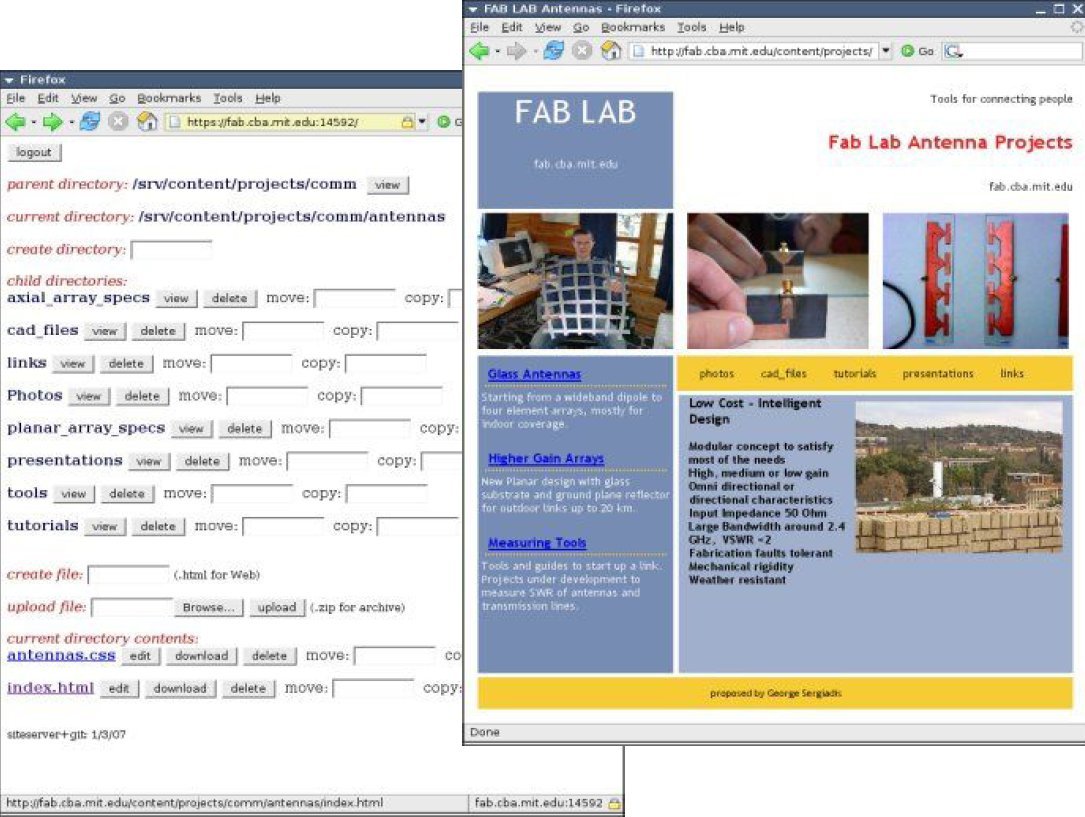
These capabilties
are being merged in a third software generation, "kokompe" (named after
a
district with mechanical repair shops in Ghana), that provides modular thin-client user interfaces
communicating with an engineering workflow server for modeling,
rendering, toolpath generation, machine control, and distributed
project management.
An example of the
use of the fab lab hardware and software is the "Scratch Patches," functional building blocks containing embedded
sensing, computing, and communications that are made from
laser-cut tiles with laminated vinyl-cut circuits, allowing kids to
assemble custom devices such as computer game controllers.

[Millner, 2005].